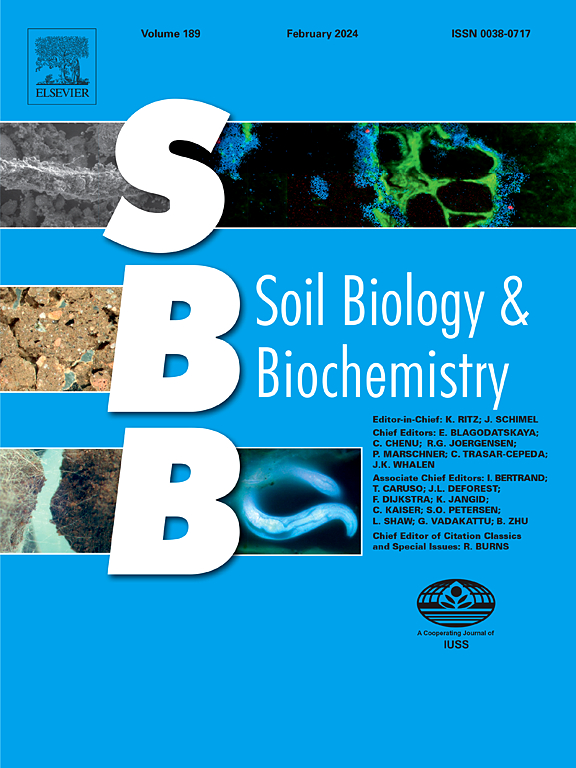Controlling matric potential in microfluidics to examine microbial dynamics in unsaturated porous media
IF 10.3
1区 农林科学
Q1 SOIL SCIENCE
引用次数: 0
Abstract
The use of microfluidics for the study of soil microbial ecology is an emerging field. Most microfluidic studies of biological systems, however, have been performed under fully saturated conditions that are not representative of natural soil. Therefore, while microfluidics offer many unique capabilities that other methodologies cannot, they are not currently suited to address the effects of matric potential, an important variable defining the microbial moisture niche. Here, a methodology is presented that allows the user to control the aqueous conditions within microfluidic networks by manipulating matric potential using a hanging water column. The method relies on hydrophilic surface treatment of the microfluidic device using polyvinyl alcohol (PVA) and incorporating a bed of small pores at the network boundaries, which serve as a porous ceramic plate analogue (PPA). The method was validated on a simple capillary bundle and then on a more complex pore network. A water retention curve, exhibiting hysteresis, was generated for the pore network over a narrow matric potential range of 0 to – 5 kPa. Both the drainage and wetting curves were reproducible, as were the spatial configuration and the number of fragmented moisture niches in the pore network, particularly on the drainage curve. In contrast, the wetting curve exhibited greater variability in spatial configuration due to the “ink bottle effect,” where capillarity was interrupted by wider pore bodies. Ultimately, the methodology provides realistic pore-scale moisture conditions that can be easily manipulated and maintained, enabling new opportunities to explore soil biophysics and microbial biogeography in unsaturated porous media. As a brief example, images showing the localization of fluorescently tagged Pantoea sp. YR343 at −4.3 kPa are presented, highlighting bacterial distributions in water films and air-water interfaces.
控制微流体中的基质电位以研究非饱和多孔介质中的微生物动力学
微流体技术在土壤微生物生态学研究中的应用是一个新兴领域。然而,大多数生物系统的微流体研究都是在完全饱和的条件下进行的,不能代表自然土壤。因此,虽然微流体提供了许多其他方法无法提供的独特功能,但它们目前不适合解决基质势的影响,基质势是定义微生物水分生态位的重要变量。在这里,提出了一种方法,允许用户通过使用悬挂水柱操纵基质电位来控制微流体网络中的水条件。该方法依赖于使用聚乙烯醇(PVA)对微流控装置进行亲水性表面处理,并在网络边界处合并小孔隙床,作为多孔陶瓷板类似物(PPA)。该方法首先在简单的毛细管束上进行了验证,然后在更复杂的孔隙网络上进行了验证。孔隙网络在0 ~ - 5 kPa的狭窄基质电位范围内产生了一条具有滞后性的水保持曲线。排水和润湿曲线都是可重复的,孔隙网络中破碎的水分生态位的空间结构和数量也是可重复的,特别是在排水曲线上。相比之下,由于“墨水瓶效应”,湿润曲线在空间结构上表现出更大的可变性,其中毛细作用被更宽的孔体打断。最终,该方法提供了易于操作和维护的真实孔隙尺度水分条件,为探索非饱和多孔介质中的土壤生物物理学和微生物生物地理学提供了新的机会。作为一个简单的例子,展示了荧光标记Pantoea sp. YR343在-4.3 kPa下的定位图像,突出了水膜和空气-水界面中的细菌分布。
本文章由计算机程序翻译,如有差异,请以英文原文为准。
求助全文
约1分钟内获得全文
求助全文
来源期刊

Soil Biology & Biochemistry
农林科学-土壤科学
CiteScore
16.90
自引率
9.30%
发文量
312
审稿时长
49 days
期刊介绍:
Soil Biology & Biochemistry publishes original research articles of international significance focusing on biological processes in soil and their applications to soil and environmental quality. Major topics include the ecology and biochemical processes of soil organisms, their effects on the environment, and interactions with plants. The journal also welcomes state-of-the-art reviews and discussions on contemporary research in soil biology and biochemistry.
 求助内容:
求助内容: 应助结果提醒方式:
应助结果提醒方式:


